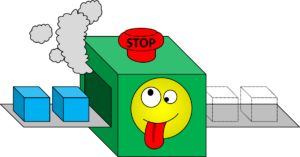Managing problems  is an important part of manufacturing because it allows companies to identify and address issues that can impact product quality, production efficiency, and overall profitability. However, it is not to be confused with actual improvement. While taking care of the problem (hopefully) makes the problem go away, actual kaizen requires that the problem should not come back.
is an important part of manufacturing because it allows companies to identify and address issues that can impact product quality, production efficiency, and overall profitability. However, it is not to be confused with actual improvement. While taking care of the problem (hopefully) makes the problem go away, actual kaizen requires that the problem should not come back.
Update: The original title of the post was “Problem Solving Is NOT Improvement”. Many readers pointed out to me that this is misleading, and problem solving is almost a synonym for kaizen… and I agree. The initial post was not worded well, and I apologize. I have changed the title and also the content accordingly. Many thanks to all for the feedback.
Problems…
 If you’re in manufacturing, or any kind of operations, you regularly will encounter problems. A machine could be broken. Material is missing. Production falls behind demand. Quality is flawed. And many more. In general, problems can affect anything in the quality-cost-time triangle (i.e., product quality, overall cost, or the time of delivery). Of course, if it affects the safety of your people or your customers or others, then safety should be the top concern! In any case, if you are in charge of a shop floor, such kinds of troubleshooting will probably occupy a lot of your time.
If you’re in manufacturing, or any kind of operations, you regularly will encounter problems. A machine could be broken. Material is missing. Production falls behind demand. Quality is flawed. And many more. In general, problems can affect anything in the quality-cost-time triangle (i.e., product quality, overall cost, or the time of delivery). Of course, if it affects the safety of your people or your customers or others, then safety should be the top concern! In any case, if you are in charge of a shop floor, such kinds of troubleshooting will probably occupy a lot of your time.
Manufacturing processes are complex and involve numerous steps and inputs, including raw materials, equipment, personnel, and technology. When something goes wrong, it can create a ripple effect throughout the entire production process. This can negatively impact a company’s bottom line, reputation, and customer satisfaction. Hence, the faster you can address problems, the better it will be for the overall operations.
Handling Problems
 Managing problem is often merely making problems go away by identifying, analyzing, and addressing problems or challenges that arise in manufacturing. If you miss parts, you try to get or make them somehow. Broken machines require repairs, flawed quality needs to be addressed, and if your production falls behind, someone has to explain to the customer why his parts are late. When problems arise, it’s critical to act fast to prevent it from affecting production and quality. Many of these problems can be fixed with effort; others, despite best efforts, impact the customer or the bottom line, or both.
Managing problem is often merely making problems go away by identifying, analyzing, and addressing problems or challenges that arise in manufacturing. If you miss parts, you try to get or make them somehow. Broken machines require repairs, flawed quality needs to be addressed, and if your production falls behind, someone has to explain to the customer why his parts are late. When problems arise, it’s critical to act fast to prevent it from affecting production and quality. Many of these problems can be fixed with effort; others, despite best efforts, impact the customer or the bottom line, or both.
Why It Is Not Kaizen
 However, just “managing the problem” is not yet kaizen. The “problem” is gine (for now), but it may be only by addressing the symptoms. The underlying cause is still there, and the occurrence of the next similar problem is just a matter of time. Overall, common ways to handle problems is mere firefighting and focuses on the short term. Just make the problem go away somehow. And, admittedly, this is valid. However, you want to resolve problems in the long run.
However, just “managing the problem” is not yet kaizen. The “problem” is gine (for now), but it may be only by addressing the symptoms. The underlying cause is still there, and the occurrence of the next similar problem is just a matter of time. Overall, common ways to handle problems is mere firefighting and focuses on the short term. Just make the problem go away somehow. And, admittedly, this is valid. However, you want to resolve problems in the long run.
Managing the problem often merely resolves the symptoms. Kaizen, however, tries to work the process. Instead of adressing a problem, kaizen works on the process (i.e., the standards, to prevent problems from happening again, or even in the first place). Kaizen is also more likely to be data driven than simple problem management (although in lean manufacturing, numbers are not everything).

Such firefighting is addressing a current crisis, whereas continuous improvement is foresight. Managing problems is often not much more than firefighting, which can lead to a culture of awarding and promoting firefighters. It is much more difficult to see, and hence to award and promote the person that prevented the fire than it is to see and promote the firefighter. I have written a whole blog post on Heroes, Firefighting, and Corporate Culture.
Also, managing problems is reactive. Usually, the problem is only addressed once it happens. Ideally, however, the system should be set up so that problems do not happen in the first place. Having firefighters in your city is good, but having good fire prevention standards is much better. A fire that did not break out in the first place is much better than a fire that was extinguished quickly. The same applies to manufacturing. Ideally, kaizen is proactive, but also admittedly, a lot of kaizen is reactive. You don’t know about a possible problem until it happens. Or—more likely—you may know about a problem, but since it has not happened yet, you hope that it is unlikely to happen, and you invest your limited resources (your time) in other more urgent problems.
The Basics on Continuous Improvement
 Continuous improvement aims to resolve the underlying issues rather than address the symptoms. The possible solutions can be as manifold as the problems. The challenge is to not only address the symptoms, but to make changes to the underlying standards so the problem does not happen again (or at least happens less often).
Continuous improvement aims to resolve the underlying issues rather than address the symptoms. The possible solutions can be as manifold as the problems. The challenge is to not only address the symptoms, but to make changes to the underlying standards so the problem does not happen again (or at least happens less often).
I know, that sounds easy, but it is definitely not. Finding the root cause is often tough. Even if you know the root cause, it may be too expensive to fix, or you may lack the levers to fix it. In lean, it is not often talked about because it is not pretty, but I believe sometimes you are just stuck with a problem that is either impossible or too expensive to fix.
On the other hand, there are plenty of problems left where a permanent solution is both possible and worth the effort. Allocate your resources to permanently resolve these problems, while at the same time do not bite off more than you can chew. However, even a well-run company will have plenty of firefighting left.
Why Many Companies Have Difficulties with That
 Again, continuous improvement is hard. It takes more effort than simple firefighting, and even then it may only reduce the likelihood of the problem reoccurring and not eliminate it altogether. Yet, I frequently come across companies that fail to do kaizen.
Again, continuous improvement is hard. It takes more effort than simple firefighting, and even then it may only reduce the likelihood of the problem reoccurring and not eliminate it altogether. Yet, I frequently come across companies that fail to do kaizen.
In some companies, the culture is valuing firefighting more than fire prevention. The employee who saved the day gets a pat on the shoulder and a possible promotion. The one who saves every day gets overlooked. I myself even at one point got a complaint from my boss two levels up that in my office there is no yelling and shouting, so obviously they are not working well. Duh! If they have to yell and shout, then the communication has broken down and we are in crisis mode. I’d rather have a quiet day in the office and get my work done.
More commonly, however, there is insufficient resources available to do proper kaizen. Resolving issues takes time, and hence you need people available to do that. Toyota has a large number of people to ensure operations run smoothly. (See for example my post On the Team Structure at Toyota). In many companies, these people have been eliminated over time. All responsibilities have been shifted to the remaining people. However, the team leader in charge of twenty-five or more people has no time to help! Same goes for the engineers and managers and office people. You need time to do things properly; otherwise everybody is just kicking the can down the road.
And yet another issue is the lack of PDCA. People do something, but nobody checks whether it still works some time later. Even if someone checks, there is no capacity left to do something if it no longer works. In the end, the problem is not resolved and happens again. Now, go out, properly resolve at least one of your problems so it does not come back, and organize your industry!

I don’t know where you got your definitions from, but I think you built your article on sand (in this case, on definitions not widely agreed upon).
The point is merely making the problem go away does not mean that the problem will not come back. Addressing symptoms vs addressing the root cause.
It is as you describe it, fixing something is a necessity to be able to continue producing.
Improving something is Kaizen, getting closer to what should be the ideal condition.
Solving problems is something from day to day, it is something that you have to do mandatorily. In my opinion, in productive areas there is no need for Heroes.
This is like an AI generated article. Problem solving does not necessarily mean addresing the symptoms only. You are confusing audience with your hodge-podge definitions and shallow recommendations.
From your current situation to the desire one, most of the time there is an unclear path where you have to eliminate problems and obstacles, to me that’s pure continuous improvement.
Fix the problem and go away without returning makes hard the CI, in this case I am agreed.
Sorry to so simply destroy your whole argument… but “problem solving” by it’s name implies that the problem was SOLVED!
True problem-solving is an Intercal part of continuous improvement. The engagement of people in the problem-solving process is how you improve and move the organization forward narrowing variation and improving quality and efficiency. Companies fail with improvement And with six sigma another methodologies because they fail to do good root cause analysis.
I had a colleage who solved problems like nobody else, a device didn’t work because a belt was slipping, he simply applied “powdered milk”…yes, as you’ve read. At the time he was the hero of the day, everyone applauded him, for thinking out of the box, only after a few hours and the device working, when the management had already left … the problem appeared again.
Continuous improvement did not exist for him, only problem solving.
So… yes…. Problem Solving is NOT Improvement.
The reality is, most of the time all of the easy fixes were already identified and done a while ago. More often than not, you will be dealing with known problems and known root causes. But fixing the root cause for good is prohibitive for a number of reasons, while much more reasonable workarounds exist.
A while ago I watched a documentary about a phosgene shed accident at a DuPont plant where a worker was killed when a hose connected to a tank ruptured. Those hoses had a very limited service life and were known to erode due to chemical interactions.
A proposal was floated to build a chemical proof enclosure to the tune of millions of dollars. Another proposal was to simply replace all of those hoses every single month regardless of condition. After the accident investigation was done, they found that the failed hose was in place for a full seven months before failure.
In my opinion, the second approach was a perfectly reasonable solution. In retrospect, the audit process to positively ensure none of the hoses were over a month old didn’t exist or was badly broken.
This article conflates problem solving with correction or immediate action (correcting deficiencies), which unfortunately is typically the only way reactive organizations deal with problems. This is just the first step is solving the problem.
I understand the overall point the author is trying to make but this is a perfect example of a sophomoric approach made overly complicated through the use of non-standard definitions. If we accept that a problem is simply the gap between current state and desired future state, then solving the problem (when does correctly) can and does create improvement; the definition of Kaizen (Kai= Change, Zen= for good; i.e positive change).
While I agree that there is a breakdown in many organizations with their approach to make lasting improvements, I would argue that, like this article, it is because they do not properly understand or define their problems.
Hello all, and many thanks for your feedback. You are right, and I used the word Problem Solving incorrectly. My apologies, and and also my thanks for the feedback. I have reworded the post, and hopefully cleared up the misused word. Cheers!
Chris.
Not to sound overly pedantic, but a title along the lines of “Constant fire fighting is not improvement” sounds much more on point.
And yes, that’s exactly what goes on in a lot of companies and shop floors. Fires get put out just enough to stop the flames, but still smolder underneath when the fire fighters run off to put out a different fire somewhere else.